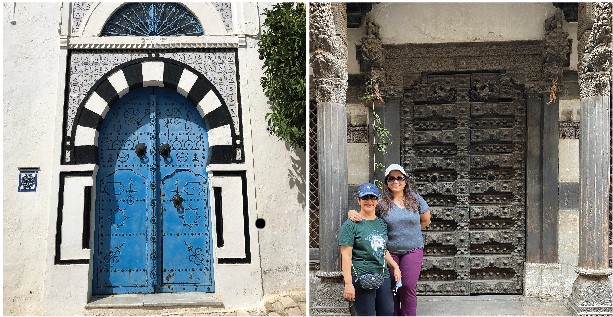Published in the Sunday Navbharat Times on 27 October, 2024
Last week, as I waited at Mumbai airport on my way to Singapore,I took a moment to reflect on how airports set the tone for a travel experience. I always prefer to arrive early, not just to avoid the rush but to soak in the environment. For many travelers, an airport is both the first and last impression of a country and some airports do this job in perfection.Mumbai’s Chhatrapati Shivaji Maharaj International Airport, in particular, feels like an art gallery, with installations that showcase India's rich cultural heritage. This time, I stumbled upon an exhibit called “India Greets”—a stunning collection of traditional doorways and facades from across the country. These intricately carved doors weren't just functional barriers; they were symbols of welcome, protection, and cultural diversity.
The symbolism of doors goes far beyond their practical use. They mark the transition from one space to another and can tell stories of a region’s history, artistry, and values. As I admired these beautiful works of craftsmanship, I was reminded that doors, much like travel, open us up to new experiences and perspectives.
The doors we pass through on our journeys can hold profound meaning, and some of the most famous doors in the world, from historical landmarks to works of art, reflect this symbolism.
One such door is the Holy Door of St. Peter’s Basilica in Rome, also known as Porta Sancta. This door remains sealed for most of the time and is only opened during Jubilee years, which occur every 25 years. The Holy Door serves as a spiritual gateway for pilgrims seeking renewal and forgiveness. The bronze panels, cast by Vico Consorti in 1950, depict biblical scenes, including Christ the Redeemer. What makes the Holy Door so powerful is the tradition associated with its opening—an event that invites pilgrims to walk through and experience a sacred journey.
Another remarkable door is the Columbus Door at the United States Capitol in Washington, D.C. Installed in 1871, these bronze doors stand 17 feet tall and weigh 20,000 pounds. They tell the story of Christopher Columbus, with intricate panels detailing his life and explorations. These doors are more than just an entryway; they represent the spirit of discovery and adventure, symbolizing America's history and future.
On the other side of the Atlantic, the Gates of Paradise at the Baptistery of San Giovanni in Florence are a testament to the genius of renaissance artistry. Created by Lorenzo Ghiberti in the 15th century, these gilded bronze doors took nearly three decades to complete. Each of the ten panels tells a story from the Old Testament with breathtaking detail. Restored in the early 21st century, the "Gates of Paradise" now gleam as a symbol of the artistic and cultural heights of the Renaissance.
Equally awe-inspiring is the Portal of the Last Judgement at Notre-Dame Cathedral in Paris. This Gothic masterpiece features carvings that depict the Last Judgement, where souls are weighed and judged. Originally crafted in the 13th century, the portal serves as a dramatic entryway into the cathedral, inviting contemplation of life, death, and redemption.
In Istanbul, the Emperor’s Door at Hagia Sophia is a historical marvel. Dating back to the 6th century, the door—also known as the Imperial Gate—leads to the main nave of the Hagia Sophia. Despite being less ornate than other famous doors, its historical significance is immense, having witnessed the transformation of the Hagia Sophia from a Christian basilica to an Islamic mosque and now a museum. The door symbolizes the resilience of empires and the passage of time.
India’s doors reflect its architectural diversity, from the intricate wooden carvings of Rajasthan to the vibrant, Portuguese-influenced doors of Goa. In Rajasthan, the grand doors of havelis and palaces are often adorned with brass studs and floral motifs, symbolizing both wealth and protection. The doors of Ahmedabad feature intricate carvings of deities and symbols, often painted in bright colors that mirror the vibrancy of the state’s culture.
In Tamil Nadu, Chettinad doors stand tall and imposing, carved from teak and embellished with brass knockers. These doors are gateways to palatial homes that once belonged to wealthy merchants, reflecting the region’s rich trading history. Meanwhile, Mughal influences in Delhi and Agra can be seen in doors featuring pointed arches and Quranic inscriptions, blending Islamic and Indian artistry.
These doors not only served practical purposes but also conveyed status, wealth, and a welcoming spirit. Each door tells a story of its region’s unique history and identity.
Doors are not only significant in history and architecture but have also become cultural icons through literature and film. For instance, 221B Baker Street is not just any door—it’s the fictional address of Sherlock Holmes, the legendary detective created by Sir Arthur Conan Doyle. Today, fans gather at the Sherlock Holmes Museum in London, eager to snap a photo in front of this iconic black door, which represents mystery, intellect, and adventure.
Another famous door is found in Notting Hill, where Hugh Grant’s character lived in the romantic comedy of the same name. The blue door at 280 Westbourne Park Road became a symbol of love and serendipity, drawing tourists and photographers from around the world.
In the realm of fantasy, Bilbo Baggins’ round, green door at Bag End from The Hobbit is perhaps one of the most memorable in literature and film. This door represents the start of an epic journey, a gateway into adventure and discovery. It adds the perfect little quirky attraction to a country like New Zealand which is blessed with astounding natural beauty.
Dilwale Dulhaniya Le Jayenge was and probably still is one of the most popular movies that not only entertained us but showcased all of Europe and inspired us all to visit Europe too. The cowbell that hangs by Shahrukh Khan's door had many fans walking through London looking for the exact door where the movie was shot! You may not find that door, but you’ll surely find the door of the home of the British Prime minister in London!The iconic door of 10 Downing Street in London, for example, was originally a simple black oak door. Today, it has been replaced with a blast-proof steel door to meet modern security needs, while still maintaining its historical Georgian style. This door, with its lion-head knocker and brass letter plate, remains a powerful symbol of British political power.
Modern speakeasies have added a playful twist to the concept of doors. A unique thing to try ion your next holiday to a modern city is to experience a speakeasy, a hidden bar whose entrance is difficult to find. In cities like New York and London, these hidden bars often feature disguised or unmarked entrances—whether behind a bookshelf, an alleyway, or a vintage telephone booth. Stepping through these doors transports guests into a secret, intimate world, adding an element of exclusivity and mystery.
From the grand Gates of Paradise in Florence to the simple yet iconic blue door in Notting Hill, doors serve as powerful symbols of transition, opportunity, and discovery. Whether they represent a spiritual journey, a historical passage, or the start of a new adventure, doors have the ability to transform our experiences.
As we move through different doors—whether literal or metaphorical—we enter new worlds, each with its own story to tell. So, the next time you find yourself standing in front of a door, take a moment to appreciate its significance. After all, every journey begins with the simple act of opening a door.
Finally in India, we take pride in decorating doorways as it is much more than an aesthetic practice; it holds deep spiritual significance. The doorway, therefore, becomes a critical element in maintaining peace and supporting spiritual discipline. As we approach Diwali, lets celebrate the festival of lights by adorning our doors with flower torans, diyas and rangolis, welcoming positivity into the home.





























































Post your Comment
Please let us know your thoughts on this story by leaving a comment.